Blu Dot: How To Make Furniture Cheap and Good
-
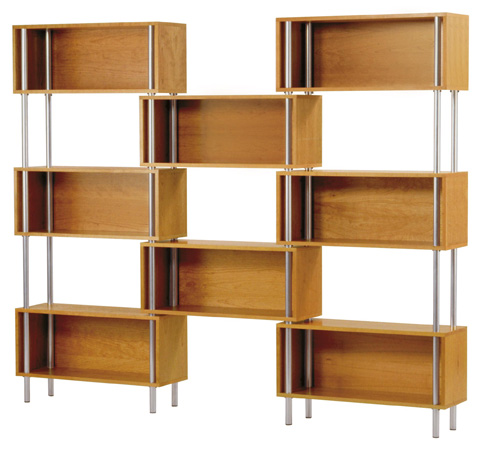 Image courtesy of Blu Dot.
Image courtesy of Blu Dot.The Chicago 8 Box
Maurice Blanks, co-founder: The “8 box” was one of our first pieces in our first collection. There are a few ways that it represents our approach to design. One is efficiency: The boxes are scaled to fit books but also to lay out on a sheet of plywood. When you finish cutting a 4 foot by 8 foot sheet of material, you have the parts that you need for those boxes, and sawdust—so there’s no waste. And the other thing we did was that we separated those boxes by some distances, so the space between became usable space. You can still put books and things in those empty spaces, but there’s no [production] cost to that.
-
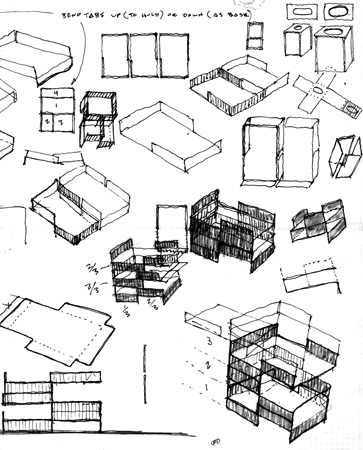 Image Courtesy of Blu Dot.
Image Courtesy of Blu Dot.2D:3D Early Sketches
John Christakos, co-founder: This idea came about not long after we launched the 8 box. We were looking to add a line of smaller pieces, but as we sat down to pencil some of these designs out and roughed out the cost, they all penciled out too high. Lots of small parts and pieces and a lot of assembly meant we were ending up with a letter holder that would cost $90, and we wanted it to cost $20. We were searching for a simpler solution, eating a pizza, and we noticed that the pizza box had perforated creases. We started thinking, could we perforate steel so that it could ship flat and then the consumer could bend it into shape and make it three-dimensional? We started playing around with different perforation patterns until we found one that could be bent by hand but was still strong enough to hold its shape. That’s how this whole line of products came about.
-
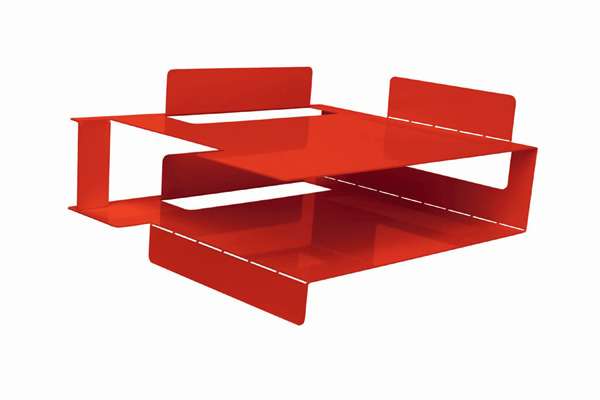 Image courtesy of Blu Dot.
Image courtesy of Blu Dot.2D:3D In/Out Box
Christakos: [These products] are almost more beautiful to us in their simplicity of manufacturing—two steps, stamped or laser-cut steel, which is then powder-coated. We had been making things up to that point that had many more steps in the process, and each step represented a possibility for something to get damaged or dinged. Our reject rates early on were really high, and it was killing us. This line of products were beautiful to us in the sense that almost 100 percent of what we made we kept. But they were also just neat objects. They looked to us as interesting flat as they did folded. This was a product that was really born out of practical problem solving.
-
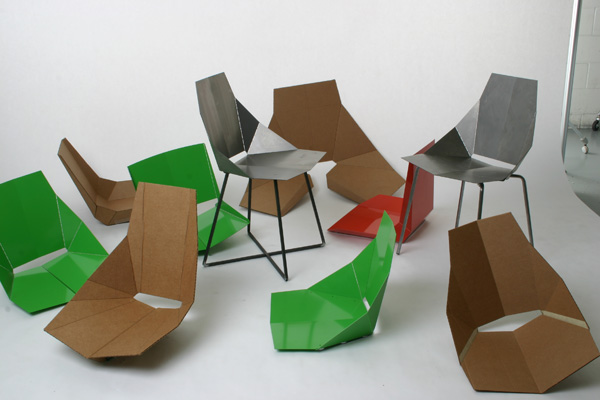 Image Courtesy of Blu Dot.
Image Courtesy of Blu Dot.The Real Good Chair
Christakos: We did a line of tables that took advantage of this “2D:3D” technology, called Barbarella. And then we thought we’d try to take it to the next step and make a chair. We were trying to make a comfortable chair of sheet metal, which is normally not very comfortable material. The whole thing ships in a carton like a pizza carton, but a little bigger. It has a handle on it so you can carry it out of the store easily. Some of the base designs we considered were going to put the retail price at $129 or $149, but when we launched it we were dead set on making this a $99 chair. It felt like the world didn’t need another expensive designer chair. We were able to launch it at $99, and to keep it there for a couple of years.
-
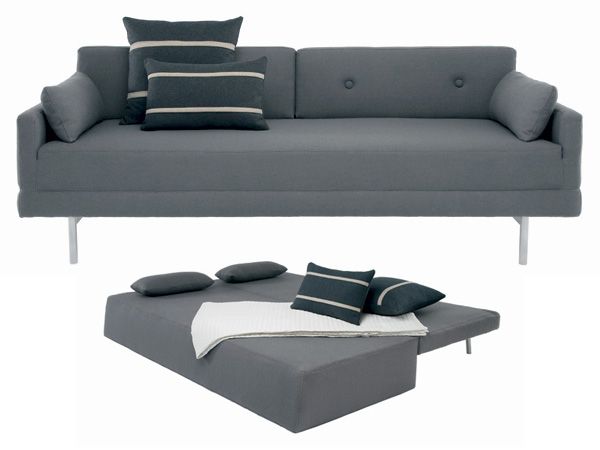 Image Courtesy of Blu Dot.
Image Courtesy of Blu Dot.The One Night Stand
Christakos: The “one night stand” is a sleeper sofa that we launched maybe two or three years ago. It’s quite popular, I think because it’s a sleeper sofa that doesn’t look like a sleeper sofa. It has a very spare silhouette, where many sleeper sofas are kind of skirted; the volume goes all the way to the floor to contain the whole sleeper mechanism. This sofa, by comparison, opens up like a book, and becomes a queen-size mattress that will fit a fitted sheet. When folded up into sofa position it looks like a nice, kind of spare, minimalist, modern sofa.
-
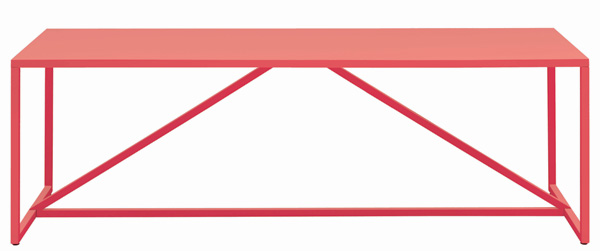 Image Courtesy of Blu Dot.
Image Courtesy of Blu Dot.The Strut Coffee Table
Christakos: You really couldn’t take anything away from this table and still have it stand up. It’s the least amount of material you can use to have a functioning table of its size. That triangular strut that goes down the center of the table picks up weight in the center of the span so the table doesn’t sag, and provides structure so the table doesn’t rack or wiggle. It also ends up being the kind of really cool, simple graphic element that makes the table interesting to look at. When we showed the table for the very first time at ICFF [the International Contemporary Furniture Fair, a major expo for modern designers] in New York, we showed it in watermelon. We thought it would be great for publishing purposes, because it’s a poppy color and really graphic, but nobody would ever want to buy it. So we made an off-white version too, and then it turned out that everybody wanted the watermelon. Sometimes we’re off on what we think will happen.
-
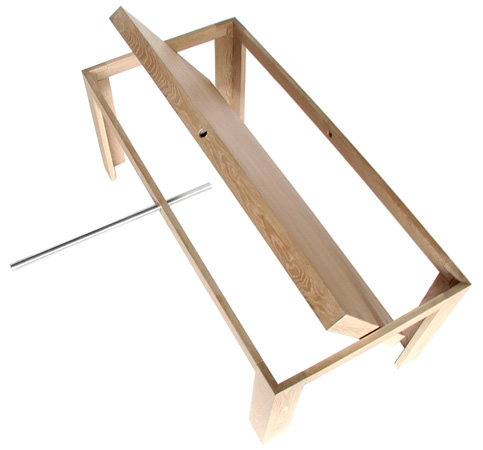 Image courtesy of Blu Dot.
Image courtesy of Blu Dot.Flip Me Dining Table
Christakos: We thought this was an unbelievably good and clever idea. It was basically a wooden parson’s structure—really simple legs coming down from the four corners, and a tabletop that had two sides. One side was wood, to match the legs, and the other side was high-pressure laminate, like Formica. The tabletop pivoted on the ends like a letter on the Wheel of Fortune, so it could flip over. At the time, our dining tables in our own houses were being used sometimes for dinner parties, but often for kids’ homework or to make legos or to do craft projects or to pay the bills. They were work tables when they weren’t being used as dining tables. So this was a table that could have a Monday-through-Friday surface and then a Saturday and Sunday wooden surface, for when you had guests over. It was a cool, practical idea, but it just didn’t work very well. I think, in the end, maybe it just wasn’t that attractive. You can have a great idea but you need the whole package: It’s got to be a good functional idea, but it also needs to be beautiful and something you want to look at every day. And that’s where that particular design fell short. It only lasted about a year before we shit-canned it, but then we had it in stock for about four years more.